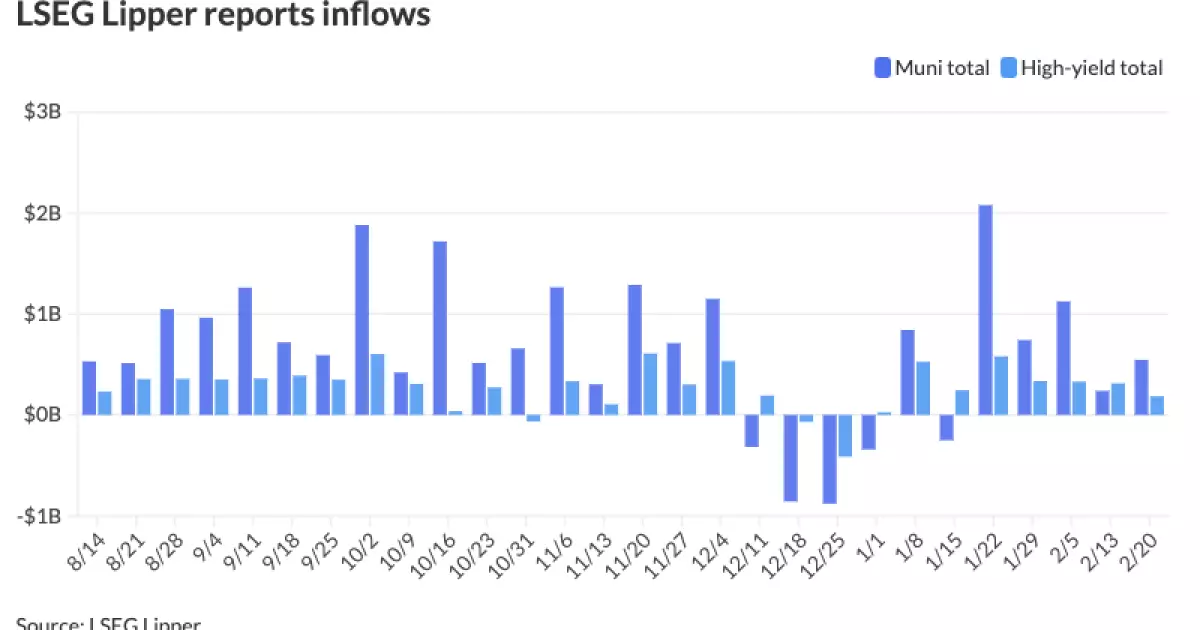The landscape of the municipal bond market is experiencing nuanced transformations, shaped by ongoing economic developments and investor behavior. In the backdrop of a $2.5 billion financing deal for the Brightline West Passenger Rail Project, market participants witnessed steady to slightly firmer municipal bond prices, a trend that accompanies decreasing Treasury yields and softer equity markets. This article aims to dissect the recent dynamics of municipal bonds amid shifting economic conditions and market sentiment.
On Thursday, the municipal bond market appeared resilient amid broader market fluctuations. The dynamics showed that investors were absorbing a modest volume of new bond issues, with the Brightline deal taking center stage. The U.S. Treasury yields, which saw a slight dip, are often viewed as a bellwether for municipal bond performance. Currently, the two-year municipal to UST (U.S. Treasury) ratio stands at a challenging 62%. The five-year ratio also reported similar statistics at 63%, with longer maturities like the 30-year municipal bonds exhibiting a higher ratio at 85%. This data underscores the intricate balance between municipal bond yields and competing Treasury securities.
The volatility in rates has been particularly notable in previous months. The spike in the 10-year UST yield to 4.80% in January was largely driven by inflation concerns attributed to tariffs, but the market corrected itself to close at 4.54%. Although fluctuations are expected, these adjustments represent an underlying stability in the economic narrative surrounding interest rates, as noted by James Pruskowski of 16Rock Asset Management. He remarked on the shifting macroeconomic factors that play a pivotal role in bond performance.
Strategists from J.P. Morgan noted that the upcoming weeks present an advantageous landscape for the tax-exempt municipal market. A combination of previously suppressed performance, reinvestment capital totaling around $18 billion, and relatively light supply augurs well for investment opportunities. The historical context reveals that when supply is low, the appetite for tax-exempt products tends to increase, bolstered by supportive fund flows observed recently.
Despite the attractive landscape, challenges loom on the horizon, particularly as we approach March-May when reinvestment capital may diminish while supply accelerates. This period is expected to test the resilience of the market as new policy implementations unfold and tax-exempt ratios stabilize, pointing towards a balance in relative value against corporates.
The behavior of investors also reveals significant insights into market psychology. Recent data shows a continued influx of capital into municipal bond mutual funds, with approximately $546.3 million in additional investments reported. Meanwhile, high-yield funds also demonstrated inflows, albeit at a declining rate from previous weeks, hinting at cautious yet steady confidence among investors.
However, a concerning trend has emerged within municipal money market funds, which experienced substantial outflows of $769 million. This decline, alongside the broader market performance, indicates a flight of capital towards riskier assets or alternative instruments, potentially reflecting evolving investor strategies in response to interest rate decisions. The average seven-day simple yield in these funds suggests competitive returns, which may attract those seeking stability in their portfolios.
The yields on long-dated high-grade municipal securities are approaching one-year highs, presenting an attractive opportunity for yield-hungry investors. Given the historical trading context, these yields, coupled with anticipated lower rates by 2025, can be seen as a compelling proposition for strategic bond buyers.
Morgan Stanley’s recent pricing of significant bond issues, including green revenue bonds linked to the Brightline project, indicates robust interest in investment opportunities associated with public infrastructure and sustainability. Such initiatives underscore the dual focus on financial returns and environmental responsibility, appealing to a growing demographic of socially conscious investors.
In summation, the dynamics of the municipal bond market are defined by a complex interplay of economic indicators, investor sentiment, and regulatory factors. As players navigate through these shifting landscapes, astute investors and strategists are likely to capitalize on the nuanced balance of risk and return, adapting their strategies to meet the evolving demands of the market. The interplay of demand, supply, and interest rate trends will continue to be pivotal as we steer through the intricacies of municipal finance in the coming months.


Leave a Reply